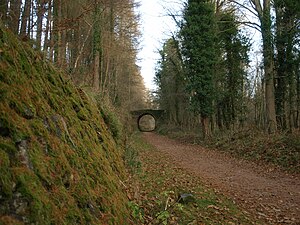Severn & Wye Railway

A section of the Severn and Wye Railway, now in use as a cycle and footpath.
|
|
| Locale | West Gloucestershire |
|---|---|
| Dates of operation | 1810–1977 |
| Track gauge | 1,435 mm (4 ft 8 1⁄2 in) |
| Previous gauge |
7 ft 1⁄4 in (2,140 mm) from 1868 to 1872 3 ft 6 in (1,067 mm) |
The Severn and Wye Railway began as an early tramroad network established in the Forest of Dean to facilitate the carriage of minerals to watercourses for onward conveyance. It was based on Lydney, where a small harbour was constructed, and opened its line to Parkend in 1810. It was progressively extended northwards, and a second line, the Mineral Loop was opened to connect newly opened mineral workings.
To facilitate transfer of traffic to the neighbouring South Wales Railway main line, the Severn and Wye Railway network was converted from a plateway to a locomotive worked broad gauge edge railway, and then to a standard gauge railway. Extensions were made to Lydbrook, Cinderford and Coleford.
The Company's finances were dependent on the mineral industry of the Forest of Dean, and in 1879 economic difficulties caused it to amalgamate with the Severn Bridge Railway. In fact this resulted in a worsening of the situation, and the combined company sold its business to the Great Western Railway and the Midland Railway jointly.
Further disappointing financial performance led to most of the passenger operation being discontinued in 1929, and after World War II inexorable decline in mineral extraction resulted in progressive closure of the network. None of the Severn and Wye Railway system is in commercial railway use today, but a heritage railway is active at Lydney.
The Forest of Dean had been a centre of mineral extraction for centuries. A coal and iron ore industry had been carried on by Free Miners, who had certain statutory rights to regulate their own affairs. Stone quarrying was also undertaken in the Forest. In the eighteenth and nineteenth centuries the timber of the Forest became an important resource for the construction of ships for the Royal Navy, creating tension with the miners who required timber for support of mine workings.
Roads in the Forest were poor and transport of heavy materials was a constant difficulty. The established rights of the Miners made the deployment of capital for large scale development very difficult, and the interest of the Royal Navy too militated against modernisation. This led to high costs, and the mining activity suffered from the competition of other locations.
...
Wikipedia
